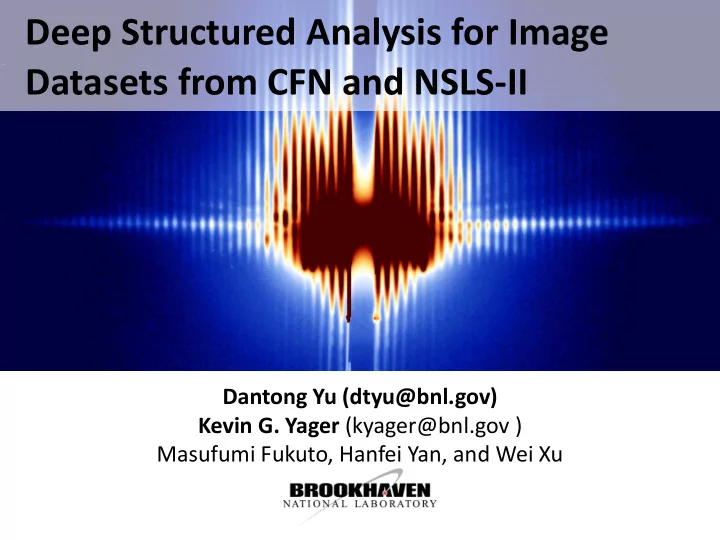

Deep Structured Analysis for Image Datasets from CFN and NSLS-II Dantong Yu (dtyu@bnl.gov) Kevin G. Yager (kyager@bnl.gov ) Masufumi Fukuto, Hanfei Yan, and Wei Xu
NSLS-II • $912M • 791 m circumference • 58 beam ports • 3 GeV, 500 mA Each x-ray beam is ~10 13 ph/s •
Motivation • Modern scientific experiments generate massive amounts of data • Complex data analysis consumes scientists’ precious time, distracting from deep scientific questions • We can train machines to perform much of the workflow • Deep learning can extract meaningful insights and detect patterns from massive amount of data; well-suited to image-like datasets
Impact to Materials Science • NSLS-II beamlines study materials from many perspectives: • Complex, multi-component, hierarchical materials • Diffraction, scattering, coherence experiments • Structure & dynamics across many scales • If machine automation/learning become part of experimental workflow, scientist is liberated to focus on scientific discoveries • Will shorten the latency between experiment to deep scientific insight, Impact for material design of battery components, solar PV, etc. • Develop at CMS and CHX; and extend to other beamlines (SMI, LiX, FXI, HXN) • To enable automated materials discovery across many synchrotron beamlines (Multimodal Analysis)
Objectives • Low-level: identifying characteristic features in a diffraction image; • Intermediate-level: detecting the occurrence of a physical process from a sequence of images; • and 3) High-level: learning and predicting scientifically-meaningful trends. • On-line Recognition and Prediction with Incremental Information • The velocity of processing must be commensurate with that of data generation.
Preliminary Work • Initial work has demonstrated the viability of applying machine-learning methods to synchrotron data • Applied machine-vision methods to tagging and classifying x-ray scattering images • Materials Discovery: Fine-Grained Classification of X-ray Scattering Images Kiapour, M.H.; Yager, K.G.; Berg, A.C.; Ber, T.L., Winter Conference on Applications of Vision (WACV) 2014 (Steamboat Springs) • Used advanced clustering methods to organize synchrotron data • Diffusion-based Clustering Analysis of Coherent X-ray Scattering Patterns of Self-assembled Nanoparticles Huang, H.; Yager, K.G.; et al., 29th Symposium On Applied Computing (SAC'14) March 24-28, 2014, Gyeongju, Korea • Exploring machine-video methods to identify events in time-sequence scattering data • Ongoing collaboration with M.H. Nguyen, Stony Brook University
New Ideas • Physical systems have natural hierarchies • Deep-learning trains multiple levels of features/representations to extract meaning from data • We will explore machine-learning hierarchies tuned to extract physics layers and meaning from scientific datasets
Technical Approach • Synchrotron images analyzed using a combination of existing domain and image-analysis techniques, as well as new algorithms • (Supervised/Unsupervised) Cluster and tag the data with physically-meaningful attributes • Attributes/features used to extract higher-order trends, and to extract scientifically- relevant insights • For example, this procedure could be mapped to a four-layer convolution neural network for trend analysis
On-Line Detection • Off-line Training, On-line detection On- line Training, on- line detection • Incremental Pedestrian Detection, Traffic Sign Recognition Update to Existing Training Model • On-line optimization Breast Cancer Cell Mitosis Detection, Volumetric Brain Image Segmentation
Co-Design Deep Learning Applications Applications DNN Frameworks TORCH WA TSON TENSORFLOW CNTK BIG DA T A THEANO CAFFE cuDNN GPUs Titan T esla TX- 1 cuDNN is a library of primitives for deep learning
Future Machine Learning Aided Material Design • X- ray scattering generates various ‘images’ that can be analyzed using machine -learning Processed area Grid of data forms Physical phase-diagram detector frame map of sample for experimental system • Computer-directed beamline experiments would allow the instrument to explore physical parameter spaces, without human intervention
Conclusion • Machine-learning is a critical component of automated materials discovery ; a new experimental mode that: • Liberates scientists to work on science • Enables computer- controlled ‘intelligent’ exploration of materials questions • Accelerate scientific discoveries + A.I. • Deep-learning is a crucial tool, allowing the computer to extract physically- relevant meaning from abstract datasets
CFN/NSLS-II Beamline: CMS • CFN/X9 program has been extremely successful: premiere, highly-sought (>2:1) scattering instrument; highly productive (>25 publications/year) • Complex Materials Scattering beamline will provide: • Sample environments for in-situ and stimuli-responsive studies of (non-equilibrium) nanomaterials • Automation and software for intelligent exploration of multidimensional parameter spaces • New paradigm for rapid materials discovery
CFN/NSLS-II Beamline: SMI • Soft Matter Interfaces beamline: high-flux and high-resolution grazing-incidence scattering instrument • Wide energy range (2 to 24 keV) for resonant scattering on hybrid (soft/hard) materials, including edges relevant to soft matter (P, S, K, Ca) • Wide q -range for studies of hierarchical materials • Microbeams (~2 μ m) for mapping of heterogeneous samples • High-flux and fast detectors for kinetic, in-situ, and in- operando experiments
Recommend
More recommend